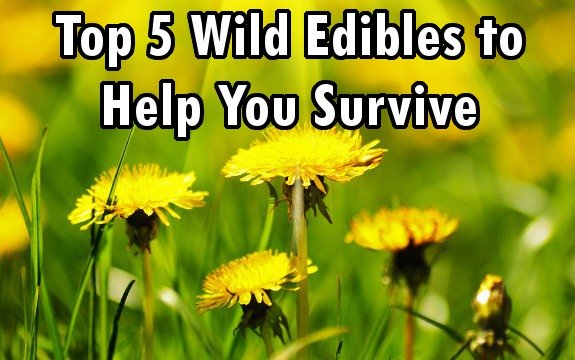Survival: Top 5 Wild Edibles to Help Keep You Alive

 If you find yourself in the wild without food—whether it’s the zombie apocalypse or a camping trip gone bad—wild plants can represent a great unknown, like an abundant buffet with poisonous dishes slipped in. It may be all green, but it’s far from all edible, and you don’t want to sample the wildlife all willy-nilly. Instead, having knowledge of a few wild edibles could come in handy, keeping you alive instead of speeding you to your death.
If you find yourself in the wild without food—whether it’s the zombie apocalypse or a camping trip gone bad—wild plants can represent a great unknown, like an abundant buffet with poisonous dishes slipped in. It may be all green, but it’s far from all edible, and you don’t want to sample the wildlife all willy-nilly. Instead, having knowledge of a few wild edibles could come in handy, keeping you alive instead of speeding you to your death.
Here are 5 wild edibles you may find and eat on your outdoor journeys:
1. Burdock
A popular food in Japan, burdock hasn’t really caught onto the mainstream here in the Western Hemisphere. It is medium-to-large sized with large leaves and flower-heads that look like purple thistles. The leaves are bitter, but edible. Both the root and stalks can be peeled and eaten raw or boiled. Burdock is a good source of carbohydrates, plant sterols, tannins, and fatty oils.
2. Cattail
A long grass-looking plant with cigar-shaped flower spikes that grows near the edge of freshwater sources, his is one of the more recognizable edibles. ArtofManliness reports these were a staple in the diets of Native American tribes. Most of the plant is edible, including the rootstock found underground. The leaves can be boiled like spinach and the stem can be boiled or eaten raw. Early in the season, the flower spike can be eaten like corn on the cob and is said to actually be similar to corn.op
Read: 8 Essential Survivalist Skills for Any Disaster
3. Dandelion
One of the most popular edibles, dandelion is an easy one to spot and often found in abundance. The leaves are packed with vitamin A and vitamin C, as well as beta carotene. It also acts like a diuretic. All parts of the dandelion are edible and can be eaten raw or boiled, though young leaves taste best. Check out dandelion benefits here.
4. Chickweed
This one is also typically found in abundance. It is a low-growing inconspicuous plant, which only reaches 3 to 8 inches off the ground. It has small white flowers with 5 petals that have clefts so deep they appear to be 10-leaved. It’s these flowers that can help one differentiate the plant from other similar species. This plant is most abundant between May and July. Leaves can be eaten raw or boiled.
5. Clovers
Clovers are easy to spot and can be found overtaking lawns and fields. They can be difficult to digest raw, so boiling is the best option. They are also high in protein, making them a perfect survival food.
Ideally, you’ll never need to result to foraging as a main source of food. However, having the information and even incorporating some wild foraging into your diet can be a useful experience. Just make sure to seek out plants that have not been treated with chemical pesticides and herbicides.

Pictures speak a thousand words
What about Plantain ( plantago – both common and English varieties ) and Puslane ? They grow wild nearly everyplace and are both highly nutritious as well as easy to identify.
oops, sorry for the typo. I meant Purslane……
Also, what about nasturtium? And, Jersulem artichoke?
groeing up in nyc my parents always sent me to camp and they always told mr that cattails were posinous also it and other things can filter sewage and make it drinkable